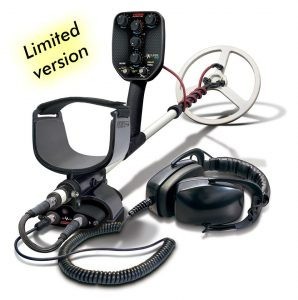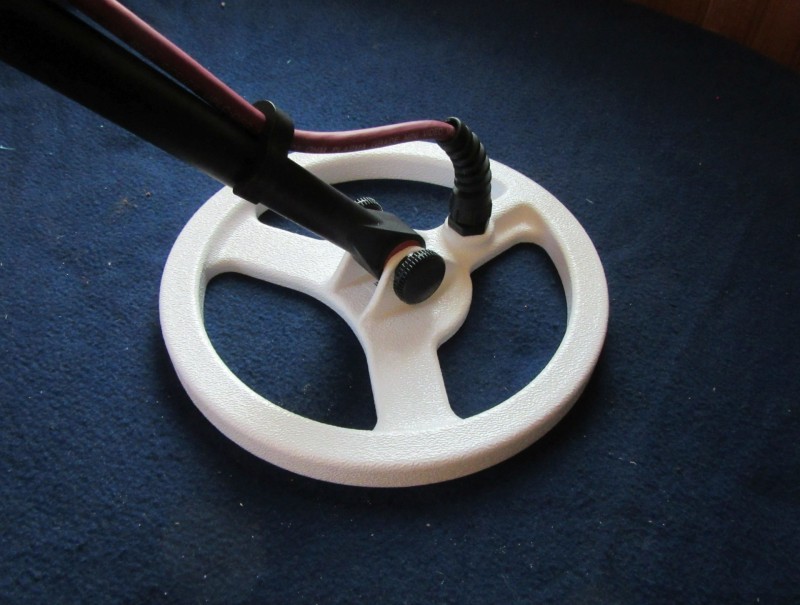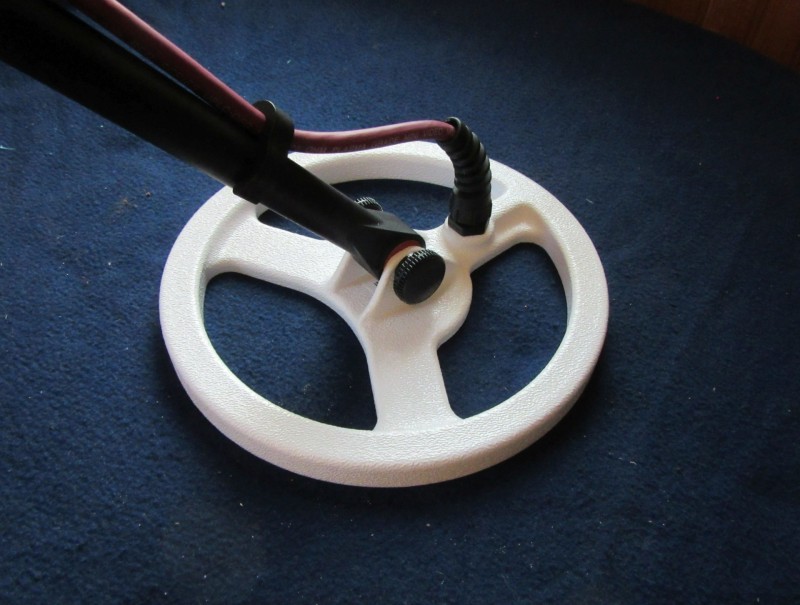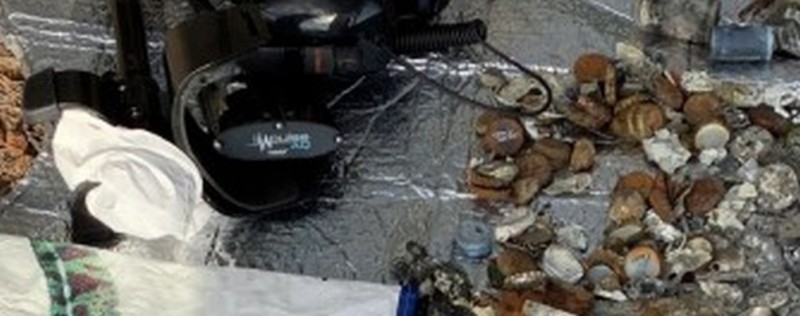-
Posts
516 -
Joined
-
Last visited
Content Type
Forums
Detector Prospector Home
Detector Database
Downloads
Posts posted by cjc
-
-
On 3/20/2022 at 1:19 PM, Steve Herschbach said:
The disc mode specifically narrows the range to the most common ring range, and cuts the rest as being mostly junk. But it does mean some outliers are lost also. Solution - just hunt all metal and do your disc by ear.
I’m glad the AQ is finally giving you some joy Clive. You sounded like you’d wrap it around a tree early on. I love the circuit and performance in general, and just hope FT can work off the rough edges in the final version.
My tests show that 22k is a bit weaker than say 18k even in the A/M mode--just what the delay / optimization is channeled to bring up the best. My first AQ had a problem Gain pot--and made noise when you touched the coil connector--the repair helped a lot--allowing me to give this machine the fair test that it most certainly deserves.
cjc
-
17 hours ago, tvr said:
That is in discriminate mode ... and I've found that even the grunts in discriminate mode that have a very narrow rise and fall signature on the tone are good targets to dig; even without going to all metal to check the response signature. Lets see what Clive says as he is more experienced with PI's than I am. I'm loving the AQ LTD now that I kind of have my head around it.
thats a good point, TVR--some of the rejects are narrow and clean sounding--demanding attention. like any machine it can mean big too.
cjc
-
Finally got a chance to run this machine in salt water. Pre factory service unit must have had problems because the stability was a lot better this time. Before it made noise when you touched the coil connector--not a good sign. The fixed one is silent and has good stability. There is still a b it of noise when the housing is near the surface but that's not hard to get used to and compensate for.
Before, I had corrosion on both power and coil jacks--played it safe this time with "CoAxSeal" putty protecting all. With minor compensation for wave action (slowing the sweep or even holding still for an instant) this machine was great. Better as an E/W. There were not really enough targets (sanded in, picked over) where I hunted to make any good depth assessments but this is a a very powerful, smooth running pulse. Certainly approaching 20". probably more on a big ring. It also has the benefit of taking non-ferrous targets right though small iron. The stock coil didn't really allow for the use of much Gain but Alexandre had mentioned to me that pre set is 85 % of the power anyhow. The small coil really channeled the power well--probably the sharpest I've seen since the Cuda 8". Seemed a bit harder to keep the machine off the iron bits with this coil but coins did sound off with a round sound. Where you heard a sharp cut off --this meant iron. Great gold optimization as well also comparable to only the Cuda. Shame that it does not like big 22k that much in the disc modes--my one concern in that these are the prize finds at my freshwater sites. I have two 10" coils coming from Eric Foster and know for sure that this size will be a good balance between the two factory coils. Thanks also to Joe for his cell--super long run time and takes a lot of the worry out with it's right angle jack. I knew this machine had tons of potential the first time I turned one on. Minor bugs ironed out a great detector that I will run alongside my Dual Field and CTX as a main machine. Thanks to FT for bringing this tech to market--and in particular Felix at FT Service for his thoroughness getting me sorted out with this detector. I've never owned a great machine that didn't have some problems. Some leak, some have parts falling off--it's part of the hobby. What count's is the end result and I'm quite happy with this one.
Regards
clive
-
Prayers for your Mum, Jeff. chance to glance at the manual while sitting together.
Kind Regards
clive
-
Thanks--I didn't think so.
c
-
Tried it today seemed to retain the saved progs. Get the sense that they have to be knocked off one by one.
c
-
I had just seen Dilek's video on the updates and had to throw in my two cents--on the wide sounding PP (how can a beginner test wide / narrow to ID iron?) and the idea of giving it a "more than you can use" Sensitivity setting like the Simplex (good to learn what moderates it). Having run the unit in salt it has lots of power and from the look of it more speed than you could apply--6 and 7 were like machine gun fire. I had assumed that the fluidity of 60 tones would work well with this machine but it was a bit frenetic--maybe my overall tuning. 6 Tones seemed deepest in air and assigned targets well. 4 Tones also sounded pretty good--still testing. Overall --phenomenal filtering . processing--very clean and orderly. The response that it likes is brought up but not with so much modulation as to distort the size.
The FerraCheck went a lot deeper than I thought it would too. Some targets that were corroded gave a couple of FE bars too and where you saw mostly NF corresponded with a broken tone, and a response that's tuning out with a few more coil passes.
cjc
-
I don't know if anyone else has had this detector in the salt water where there is a lot of iron but I was very Impressed by the audio, target assignment and overall processing. This thing is fast and deep.--even in the MW preset. It brought up targets in an area that NOX and Excalibur hunters had been in for days. Unbelievable what you get for your money these days--a great value. I ran at Sens 25 Speed 5 or 6, Stability 1 or 2 and experimented with 4, 6 and 60 tones. If anyone has done any testing to determine if the Legend brings up targets best at higher or lower Speeds--let me know.
cjc
-
On 3/2/2022 at 9:36 PM, Jeff McClendon said:
I would never even consider doing 4 foot repetitive drop tests on concrete using an Equinox or Deus like the ones Jeremy did to his Legend along with throwing it several times and kicking it. Amazing.
To me it's all about basic theory. People run from that kind of learning like the --well you know.. virus.
So lets take Modulation. I can give someone a pretty good run down on how Modulation will affect their detecting experience in a couple of paragraphs. "Modulation is a software feature that --in order to keep a handle on the wild noise of a high gain, multi FQ signal--it makes everything sound more the same. So it both mutes and amplifies at the same time." Done. However without that information an Equinox user gets out there and can't understand why the machine is booming on little flyspecks of foil and conversely, bringing pop can and sunglass signals down to sound coin size. So he puffs out his chest, gets on his YouTube channel and does a viddy: "My machine won't tell size...! What a piece of junk!" Multiply that by all the improvements in detectors over the last few years and you arrive at the present situation. Too many hunters are talking about effects--not causes and these effects have become the conversation.
-
2 hours ago, Tony said:
Clive,
Who makes that coil…..is it Fisher’s or from someone else?
Hi Tony It's factory.
clive
-
Sounds like you got it. Had rooted around in the manual but didn't find that--thanks. A full reset can often solve a lot of problems lol....
cjc
-
Has anyone figured out how to do a factory reset on this machine?
cjc
-
15 minutes ago, Rivers rat said:
Cute coil!!!!
RR
She's a beast! Really channels the machine's power well.
cjc
-
-
-
3 hours ago, Dan(NM) said:
Thank you for taking the time and effort to gives us a nicely written first review? Can I assume your a Nomad since you have a Legend 🙂
No not a Nomad they are shipping this week.
cjc
-
Legend, First Look...
-very, very nice build quality—very solid feel but much lighter than the Anfibio. Wand telescopes in and out much more cleanly. Coil is a tiny bit heavier than the AF28 to accommodate the MF winding.
-overall a nicely balanced unit-not so light as to make a larger coil “top heavy.”
-lot of information on the screen keeps all of your choices visible, very well laid out. Super fast access to any feature / adjustment. Maybe takes a bit of getting used to just how much is there. 1st day I’m already flying around it.
-great sounding audio, not “bitty,” nice faint range, not over-modulated.
-good tones come though the digital noises well, even at high Sensitivity levels. Reminds me more of the CTX than the NOX—full, strong sounding tones, clean processing and target assignment. (Indoor testing tells you a lot about how a machine handles any kind of interference).
-recovery speed just barely takes air test targets at full on--(so much for any of these “conclusive” on-ground videos). This is a feature that’s designed to work in ground while processing the full MF signal and ground. I would add that an Iron Bias control, added to this speed has the potential to clip / loose targets—possibly the reason why N/M initially opted for a pre-set. Where you have a lot of corroded or alloyed metal though (such as bottle caps), adjustable Iron Bias certainly improves the versatility and effectiveness of the machine. Not a feature to be taken lightly though—an advanced setting.
-turned down to Rec Spd 2, unit passes “iron cross” test with a medium sized band and two rusted spikes. Perfect tone and ID.
-big difference between M1 and M2 settings M2 has much more low conductor sensitivity, livelier, sharper tone overall.
-good, versatile selection of single FQs. I like the addition of “10” kHz as a “middle” high conductor / bad ground search mode. If the Anfibio is any indication I know that the 20 kHz will be sharp on gold and nimble in iron.
-Gold mode—the audio of this mode shows the sophistication of the filtering / processing. Clean, fast responses. Looks like a great fresh water black sand / edge “cherry picker.”
-I like the addition of a Stability control to augment (or even stand in for) normal signal balancing methods that often take a lot of trial and error to use effectively. Doesn’t seem to constrain the signal that much in air-seems like a combination of (lowered) FQ weighting and a low level adjustment of Discriminate and 1st Tone Break? I know for sure that this feature will allow the use of higher Sensitivity settings.
cjc
-
7 hours ago, GB_Amateur said:
Thanks for taking us along. Some of the early targets (lead sinkers) seemed to give low (non-ferrous?) tones mixed in with the intermediate tones. Was there iron (e.g. clasps) associated with those weights? If not, do you think this might be an expose' of the fixed iron bias of the current model (pre- iron bias adjustment update)?
If I recall, your first N/M Legend video done with the pre-release test version had zinc cents hitting ~37 and copper cents about 43-44 (please correct me). Were those two rings right in there with the copper cent VDI's?
Finally, do you notice volume variation with depth or is too early with your new instrument to pick up on that?
While Im testing indoors (-6 today and frozen solid) this machine seems to have a very nice faint range--a good fade out in all modes.
cjc
-
On 1/1/2020 at 9:50 PM, LowTide said:
After reading the above I was under the impression that iron and steel could be rejected by the user once they had become familiar with it's tonal clues. Elsewhere LE.JAG had posted a photo of an outing showing all of the recovered targets. I have cropped and resized that photo which has created the graininess. My concern are the number of rusty steel crown caps to the right in the photo. Beaches I detect are heavily littered with these and multitudinous digging 15-20 inches is not going to help efficiency or my back.
Narrow, peaked signals--that's how I stay off the caps with any of my pulses. What you are doing is exaining how the target relates to the surrounding ground. When the machine is able to make this separation more easily--non-ferrous.
good luck, clive
-
That's certainly the way I see it too, Chase--right tool for the job. The AQ Limited does have a place in that tool box though--maybe in the front with a bit of hands on and coil wrangling. The D2 needs a lot more messing with to see what it's got-- I just don't chose to be one of the early adapters at that price point / exchange. Also, as we've all seen--free detectors tend to cloud one's judgment😆 Certainly hopeful though.
cjc
-
On 12/13/2021 at 8:28 AM, okara gold said:
Cjc... Earlier this year the 7 and 7.5 delay setting on my machine was hardly reacting to anything and was roughly equivalent to an 11 setting. I could turn to the 7 delay in the salt water and it was very quiet and would hardly pick up a target. It was sent back to Fisher and repaired to work as it should. I have had several problems with the pots going bad. Volume control was another.
Just reviewing whats been said about the AQ now--sorry to take so long to respond. I will say that these low delay settings are super finicky and will blank due to EMI or just strong sand. They either tune or they dont. I know this from my TDI and other low runinng Eric Foster machines.
cjc
-
My pleasure, Chase. But if the D2 is only doing 10" on targets in salt water- (Dive mode) -why take it in at all? May as well just bring your air mattress. Had I not heard that there would be one on my basement floor at this moment. Another Anfibio in this respect. As a land machine it sounds excellent though.
As for the AQ Im not sure if they conditions I've tried it in are exceptional but believe that a small coil of this size (8") will help. I did have one of Eric's small coils (10") that was pretty good but there was also corrosion on the power jack preventing a fair assessment. The coil also had problems and he now has it to look over.
Just getting ready to test the Legend in sat as well. In that it was specifically developed to overcome the salt water problems of the Anfibio--guessing that its going to be pretty good.
Good Luck,
clive
-
11 minutes ago, Chase Goldman said:
More like contest over once the D2 goes past the Impulse rated submersion depth by about 19 meters. I like jokes, thanks for making my day by setting that up for me, Clive.
I'm happy you got your unicorn working at last. Many others not so lucky or happy. Now go get some gold with that Impulse. Doubt we'll ever see the final production version...
-
On 1/17/2022 at 7:05 AM, Chase Goldman said:
So...I get why we haven't seen an Impulse AQ bake off against D2 to date, but where has this comparison vs. the Nox been all these months?
Looking at Alexandre's 7 point list, my swag is that D2 is going to represent quite well. Would really like to see those results...
...about 8 inches deeper--contest over. Maybe more...😆
cjc







The Hunter Gt Tests Ctx, Deus 2, Nox And Legend
in Metal Detector Advice & Comparisons
Posted
The sense I get is that these ultra light machines try to substitute digital wizardry for pure processing power. That power is heavy just as was the Sovereign. However where you have a number of adverse things that would overwhelm said circuit--fast salt, incline, iron, black / grey sand summating to overwhelm detection--this is where these software dandies show weakness. The NOX for example can just barely process it's own big coil in salt and goes into digital "clickey-click" noises. Also, many of these types of comparison tests ignore the fact that what a detector does is to SEPARATE metal from ground and therefore hyped up almost random settings may not be what's needed to accomplish this separation. Everyone wants to take this gonzo jam the signal down approach and compare on that basis. A signal balancing approach is based upon letting the conditions dictate--not being taken in by industry hype and superlative claims. As this video shows--with that approach--one of these new ultrallght supercomputor type machines is as good as the next--and the tough conditions show that even more. At all of the sites I hunt there's a "troll under every bridge." I succeed not by having the latest machine but by knowing when to use which one of the old ones--and how to tune those based upon what the conditions will allow--not wishful thinking. Even the Excalibur will lose depth without losing threshold and a lot of hunters miss targets because they don't understand basic multi FQ theory. I count on it.
cjc